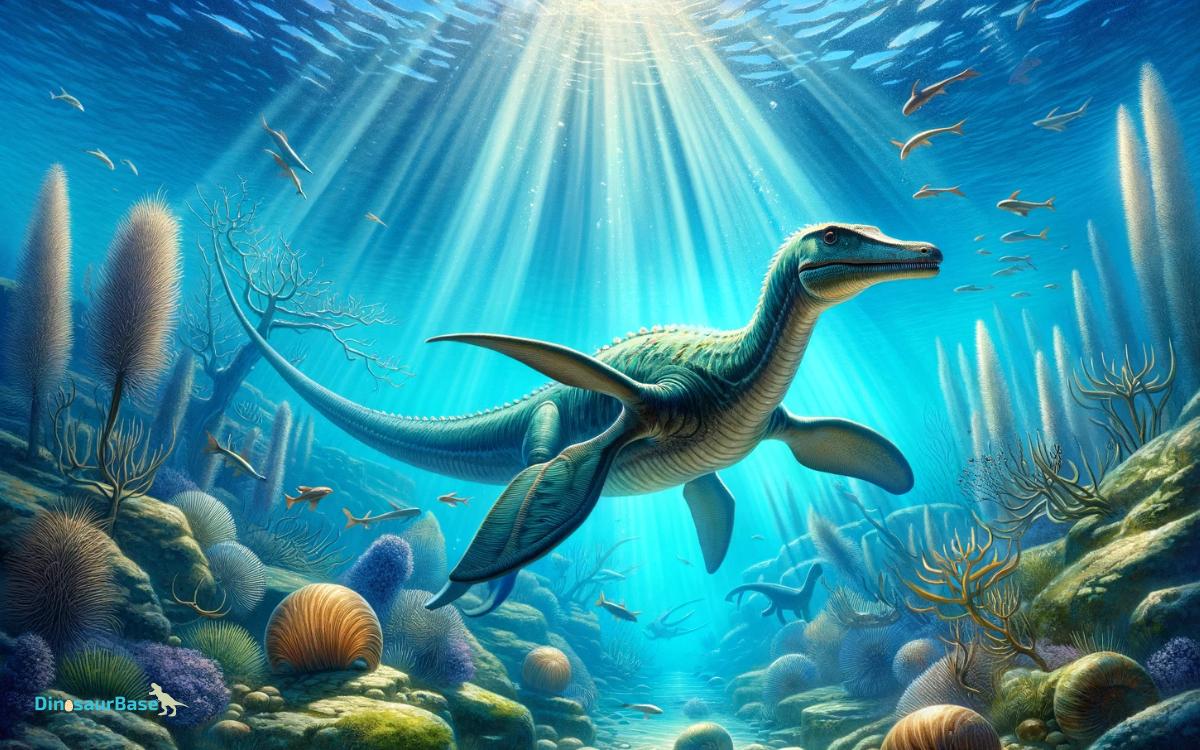What Dinosaur Lives in Water? Ichthyosaurs!
Like a relic hidden beneath the waves, the mighty Mosasaurus reigns supreme in discussions about aquatic dinosaurs, though it’s technically a prehistoric marine reptile.
This behemoth of the ancient seas sparks curiosity with its formidable size and fearsome reputation.
However, it’s not the only creature that called the water home.
From the semi-aquatic Spinosaurus, known for its distinctive sail, to the elegant Plesiosaurs that glide through the ocean depths like mythical serpents, the variety of water-dwelling dinosaurs and reptiles is astounding.
Their adaptations and lifestyles hint at a world as alien as it is fascinating, inviting further exploration into their ancient domains.


Key Takeaway
The Mighty Mosasaurus
Among the formidable predators of the prehistoric seas, the Mosasaurus stood out for its immense size and powerful jaws, dominating marine ecosystems during the Late Cretaceous period.
This marine lizard, reaching lengths up to 50 feet, wasn’t a dinosaur but a mosasaur, a term that distinguishes its lineage.
Its physical structure featured a robust, elongated body, flippers for steering through water, and a tail fin that provided powerful propulsion.
The Mosasaurus’s diet was diverse, consisting of fish, sharks, and even smaller mosasaurs, showcasing its apex predator status.
Its teeth were conical and designed for gripping slippery prey, preventing escape.
Scientists have pieced together its lifestyle through fossilized remains, revealing a creature adept at navigating and controlling its aquatic environment, securing the Mosasaurus’s place in the annals of prehistoric marine life.
Spinosaurus: The Semi-Aquatic Predator
Transitioning from the marine reptiles of the Late Cretaceous, the Spinosaurus emerges as a unique semi-aquatic predator of the mid-Cretaceous period, characterized by its distinctive sail-like spine and versatile hunting abilities.
This formidable dinosaur’s adaptations allowed it to thrive both in water and on land, highlighting an evolutionary marvel. Its elongated jaw and conical teeth were ideal for catching fish, while its massive size deterred most predators.
- Awe-Inspiring Size: The Spinosaurus could reach lengths of over 50 feet, making it one of the largest carnivorous dinosaurs.
- Unique Adaptations: Its nostrils placed high on the skull facilitated breathing while submerged, showcasing evolutionary ingenuity.
- Mysterious Lifestyle: Recent evidence suggests a predominantly aquatic lifestyle, challenging previous notions and inviting further research into this magnificent creature’s habits.
Plesiosaurs: Oceanic Elegance
Plesiosaurs are distinguished by their long necks and small heads, exhibiting a unique anatomy among marine reptiles. Their hunting techniques leverage this distinctive feature, allowing them to capture a wide range of prey with surprising agility.
This section explores the intricacies of Plesiosaur anatomy and their adept methods of securing sustenance in ancient oceans.
Plesiosaurs’ Unique Anatomy
Renowned for their distinctive body structure, plesiosaurs boasted a unique combination of elongated necks and small heads, setting them apart in the marine reptile lineage.
Their anatomy presented an elegant adaptation to aquatic life, marked by several key features:
- Hydrodynamic Bodies: Their streamlined shape minimized water resistance, facilitating smooth, efficient movement through ancient seas.
- Powerful Flippers: Four strong, paddle-like flippers allowed for precise maneuverability and stability in water, enabling them to glide gracefully.
- Flexible Necks: The elongated necks, equipped with numerous vertebrae, provided a wide range of motion, crucial for scanning underwater environments and potential prey capture strategies.
These anatomical attributes underscore plesiosaurs’ evolutionary mastery, embodying the harmonious balance between form and function in the aquatic realm.
Hunting Techniques Explored
Having explored the unique anatomical features of plesiosaurs, it’s now crucial to examine how these characteristics facilitated their predatory tactics in ancient oceans.
Plesiosaurs, with their elongated necks and small heads, were adept at ambushing prey. Their flipper-driven propulsion allowed for swift, agile movements, essential for catching fish and cephalopods.
| Feature | Impact on Hunting Technique |
|---|---|
| Elongated Neck | Enabled stealthy, surprise attacks from a distance. |
| Small Head | Minimized water resistance, improving speed and agility. |
| Large Flippers | Provided powerful propulsion for chasing prey. |
| Streamlined Body | Enhanced maneuverability in aquatic environments. |
These adaptations underscored their dominance as apex predators, showcasing a blend of stealth, speed, and agility that was unparalleled in the marine ecosystems of their era.
Ichthyosaurs: Dolphins of the Past
Turning our attention to Ichthyosaurs, their evolutionary origins offer a fascinating glimpse into how these marine reptiles adapted to life in ancient seas, converging in form and function with modern dolphins.
Their physical characteristics, including streamlined bodies and large, fin-like appendages, optimized their efficiency as powerful swimmers and hunters.
Analyzing their hunting strategies and diet reveals their apex predator status, relying on keen vision and a diverse diet of cephalopods and fish to dominate their aquatic ecosystems.
Evolutionary Origins
Ichthyosaurs, often likened to the dolphins of the past, evolved from land-dwelling reptiles that returned to the sea during the early Triassic period, adapting remarkably to their aquatic environment.
This transition marks a significant evolutionary adaptation, showcasing the dynamic nature of life on Earth.
- Wonder: The transformation from terrestrial to fully aquatic life forms ignites curiosity about the diversity and adaptability of ancient species.
- Awe: The vast evolutionary timeline, over millions of years, underscores the complex processes that shape life.
- Respect: Understanding the evolutionary origins of ichthyosaurs fosters a deeper appreciation for the intricate patterns of natural history.
These creatures exemplify the incredible journey of evolution, demonstrating how life can flourish in the most unexpected places, adapting in ways that seem almost beyond the realm of possibility.
Physical Characteristics
Mirroring modern dolphins in form, these ancient marine reptiles boasted streamlined bodies that sliced through the water with remarkable efficiency. Their physical characteristics were a testament to their adaptation to a fully aquatic lifestyle.
Ichthyosaurs possessed a fusiform body shape, reducing drag and enabling swift movements through their aquatic environment. This shape is optimal for animals that rely on speed and agility in water.
Their flippers, resembling those of today’s dolphins and whales, were strong and paddle-shaped, designed for steering and stabilization rather than propulsion, which was primarily the role of their vertically oriented, fish-like tail.
The convergence of these physical traits with cetaceans underscores the principle of evolutionary parallelism, where unrelated species evolve similar traits to adapt to comparable environments.
Hunting and Diet
Like modern dolphins, these prehistoric marine reptiles were adept hunters, utilizing their keen senses and agile bodies to capture a diverse array of prey in the ancient oceans. Ichthyosaurs thrived during the Mesozoic era, a period marked by a rich marine ecosystem.
Their diet was predominantly composed of:
- Small Fishes: Swarming in vast schools, these provided a plentiful and constant food source.
- Cephalopods: Including squids and octopuses, which required a more strategic hunting approach due to their mobility and defensive mechanisms.
- Ammonites: Encased in hard shells, these creatures demanded precision and strength to access the nutritious contents within.
Their remarkable adaptation to marine life, including a hydrodynamic body shape and acute vision, enabled ichthyosaurs to excel in a variety of hunting scenarios, cementing their place as formidable predators of their time.
The Enigmatic Elasmosaurus
The Elasmosaurus, a marine reptile of the Late Cretaceous period, exhibits a fascinating adaptation to aquatic life through its exceptionally long neck and streamlined body.
This unique design facilitated its survival in prehistoric oceans, allowing it to stealthily approach prey with minimal disturbance to the water.
Its neck, comprising up to half its total body length, wasn’t just a physical marvel but a strategic hunting apparatus. Scientists believe this elongation enabled the Elasmosaurus to create an ambush zone, striking swiftly at fish and cephalopods from a distance.
Despite its formidable appearance, the creature likely relied on its agility rather than strength, given the relatively small size of its head and the presumed weak bite force.
This adaptation underscores the evolutionary ingenuity inherent in ancient marine ecosystems.
Archelon: The Ancient Sea Turtle
Shifting focus to another remarkable inhabitant of ancient oceans, Archelon, the giant sea turtle, presents an extraordinary example of adaptation and survival in the marine realm.
This ancient creature, which lived approximately 75 million years ago during the Late Cretaceous period, has intrigued scientists for its remarkable size and evolutionary adaptations.
- Size: Archelon could reach over 4 meters in length, dwarfing modern sea turtles.
- Adaptations: Its paddle-like flippers enabled efficient navigation through prehistoric seas, highlighting evolutionary excellence.
- Shell Structure: Unlike modern sea turtles, Archelon’s shell was relatively soft, offering insights into its unique defense mechanisms.
These characteristics not only stir a sense of wonder but also underscore the complexity of ancient marine ecosystems and the evolutionary prowess of its inhabitants.
Exploring the Depths With Liopleurodon
Diving into the Mesozoic era’s marine environments, Liopleurodon emerges as a formidable predator, renowned for its massive size and powerful jaws.
This marine reptile dominated the waters, leveraging its acute senses to locate prey. Its streamlined body facilitated swift, agile movements, making it an apex predator of its time.
| Feature | Description |
|---|---|
| Era | Middle to Late Jurassic |
| Size | Up to 25 feet in length |
| Habitat | European shallow seas |
| Diet | Carnivorous, including fish and other marine reptiles |
Liopleurodon’s anatomical adaptations, such as its large, conical teeth, were ideal for gripping slippery prey, indicating a diet that primarily consisted of other marine creatures. Its presence in the fossil record underscores the diversity and complexity of prehistoric marine ecosystems.
Conclusion
In the ancient waters, giants once ruled, their legacy a testament to nature’s grandeur.
The Mosasaurus, with its daunting size, the Spinosaurus, a bridge between land and sea, and the elegant Plesiosaurs, alongside the dolphin-like Ichthyosaurs, painted a vivid tableau of life beneath the waves.
The enigmatic Elasmosaurus and the colossal Archelon, with Liopleurodon’s depths exploration, remind us of the Earth’s perpetual evolution. Through a scientific lens, these creatures’ stories fuel our wonder, forever captivating the human spirit in the dance of discovery.



